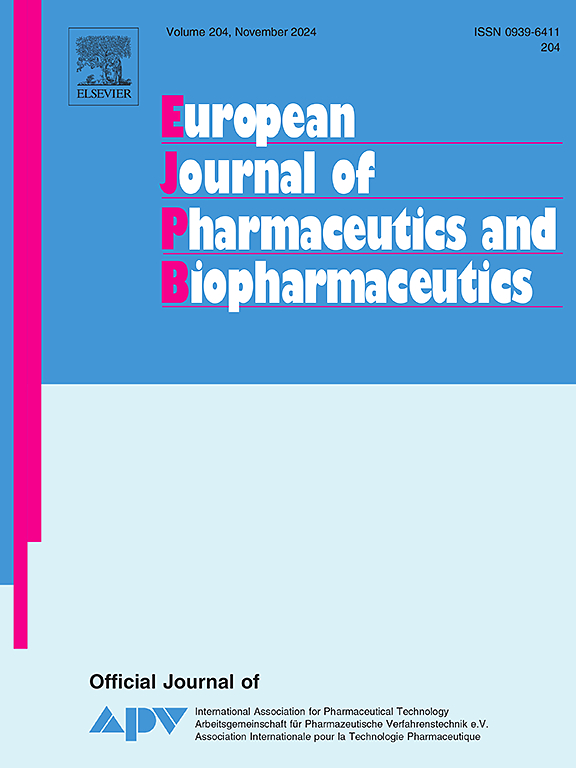Minimally invasive treatment of fungal keratitis with voriconazole microneedle corneal patch
IF 4.4
2区 医学
Q1 PHARMACOLOGY & PHARMACY
European Journal of Pharmaceutics and Biopharmaceutics
Pub Date : 2025-04-04
DOI:10.1016/j.ejpb.2025.114717
引用次数: 0
Abstract
Fungal keratitis, a disease caused by fungal infection of the cornea, is an eye disease with a high rate of blindness. Despite voriconazole (VCZ) has a good therapeutic effect in the treatment of fungal infection, the use of VCZ in the eye is limited due to the poor solubility of VCZ and the special physiological structure of the eye. In this study, a soluble microneedle (MN) containing VCZ micelles was designed for the eye to effectively deliver VCZ for the treatment of fungal keratitis. The water-insoluble VCZ was first encapsulated into the micelle prepared by polyethylene glycol-15-hydroxystearate (HS-15), and then mixed with hyaluronic acid (HA) and polyvinylpyrrolidone K30 (PVP K30) to create the microneedle patches loaded with voriconazole micelles (VCZ-MN) using a simple mold molding method. Fourier transform infrared spectroscopy (FTIR) and differential scanning calorimetry (DSC) analysis showed that VCZ was amorphous dispersed in the MN patch. According to in vitro drug release studies, MN patches can consistently release drugs within 6 h. Following the in vivo application of MN, the retention time in the eye is extended to more than 3 h and has good eye biocompatibility. In addition, MN can reversibly penetrate the corneal epithelium and recover within 24 h. The results of in vitro antibacterial study showed that VCZ-MN had good antibacterial activity. The results of eye tissue distribution showed that maximum concentration (Cmax) and area under the concentration–time curve from time zero to infinity (AUC0-∞) in cornea and aqueous humor in MN group were significantly higher than those in eye drops group. The results indicated that VCZ-MN could significantly increase the concentration of VCZ in eye tissue and eye bioavailability. Therefore, VCZ-MN as a minimally invasive drug delivery device, can be used as a safe and effective way to treat fungal keratitis.

伏立康唑微针角膜贴片微创治疗真菌性角膜炎
真菌性角膜炎是一种由角膜真菌感染引起的疾病,是一种致盲率很高的眼病。尽管伏立康唑(voriconazole, VCZ)在治疗真菌感染方面具有良好的疗效,但由于VCZ的溶解度较差以及眼睛特殊的生理结构,限制了VCZ在眼睛中的应用。本研究设计了一种含有VCZ胶束的可溶性微针(MN),用于眼部有效输送VCZ治疗真菌性角膜炎。首先将不溶于水的VCZ包被在聚乙二醇-15-羟基硬脂酸酯(HS-15)胶束中,然后与透明质酸(HA)和聚乙烯吡罗烷酮K30 (PVP K30)混合,采用简单的模塑方法制成装有伏立康唑胶束(VCZ- mn)的微针贴片。傅里叶变换红外光谱(FTIR)和差示扫描量热(DSC)分析表明,VCZ以无定形分散在MN贴片中。体外释药研究表明,MN贴片可在6 h内持续释药,体内应用MN后,在眼内滞留时间延长至3 h以上,具有良好的眼生物相容性。此外,MN可在24 h内可逆穿透角膜上皮并恢复。体外抗菌研究结果表明,VCZ-MN具有良好的抗菌活性。眼组织分布结果显示,MN组角膜和房水的最大浓度(Cmax)和从时间0到无穷远的浓度-时间曲线下面积(AUC0-∞)显著高于滴眼液组。结果表明,VCZ- mn能显著提高VCZ在眼组织中的浓度和眼的生物利用度。因此,VCZ-MN作为一种微创给药装置,可以作为治疗真菌性角膜炎安全有效的方法。
本文章由计算机程序翻译,如有差异,请以英文原文为准。
求助全文
约1分钟内获得全文
求助全文
来源期刊
CiteScore
8.80
自引率
4.10%
发文量
211
审稿时长
36 days
期刊介绍:
The European Journal of Pharmaceutics and Biopharmaceutics provides a medium for the publication of novel, innovative and hypothesis-driven research from the areas of Pharmaceutics and Biopharmaceutics.
Topics covered include for example:
Design and development of drug delivery systems for pharmaceuticals and biopharmaceuticals (small molecules, proteins, nucleic acids)
Aspects of manufacturing process design
Biomedical aspects of drug product design
Strategies and formulations for controlled drug transport across biological barriers
Physicochemical aspects of drug product development
Novel excipients for drug product design
Drug delivery and controlled release systems for systemic and local applications
Nanomaterials for therapeutic and diagnostic purposes
Advanced therapy medicinal products
Medical devices supporting a distinct pharmacological effect.

 求助内容:
求助内容: 应助结果提醒方式:
应助结果提醒方式:


